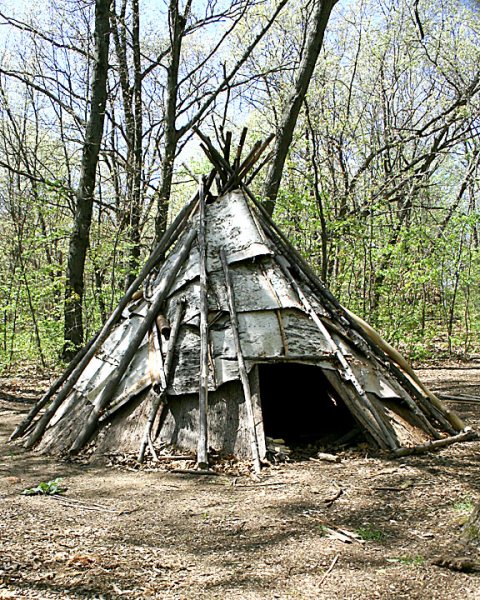Shelter Rules and Concepts
by George Hedgepeth
Large shelters are harder to heat and take more materials to build, but they are more comfortable and handle smoke better than a small shelter.
The poorer the quality of thatch, the steeper the pitch of roof must be to shed hard rain. For example, sheets of cedar bark used as shingles can be effective on a much flatter roof than layers of pine boughs.
If light can penetrate a roof or a wall, so can wind and rain.
The ground is COLD. In warm conditions, it can be crawling with critters. Make a floor for your shelter, elevate it, or make a raised bed. You will sleep better and regain more energy.
No shelter of primitive materials can be built as rapidly as one can string up a tarp, and most are not as weather proof. It pays to carry some cord and a light-weight weather barrier.
A high roof handles smoke much better.
A low roof is easier to heat.
A shelter must take local conditions into account. A rain proof, transparent sheet is of little use in the Sahara. Native shelters in a particular area are excellent guides to what WORKS in an area.
Think of a debris hut as a SLEEPING BAG, not a house. They can be made relatively quickly in the correct conditions, but take a fair amount of materials. They can be warm, but they can harbor a tremendous amount of vermin, and they cannot be used with a fire.
A shelter with a fire inside requires high quality fuel to not be unbearably smoky. It needs to be dry, and split if over 2 inches or so in diameter.
Location is even more important in the wilderness than in real estate. Flood zones, dead overhanging branches, hornetís or antís nests, and animal runways are things to avoid. Proximity of water and materials, good drainage, and suitable micro-climates (being out of the wind or being near heat saving boulders are good examples) are things to look for.
A shelter in use for an extended time can be improved a bit every day. Boughs used for flooring or bedding should be deepened or replaced often.
In areas with large predators, it is a good idea to keep, prepare, and eat food (especially meat) in a separate location AWAY from the main camp.
Hygiene is important. Locate your latrine away from your camp and fresh water.
An additional benefit of an elevated bed is that it provides a place to sit. Most western people get tired of sitting on the ground in a hurry.
Natural material shelters are hard to see by their very nature. If awaiting rescue, keep this in mind. Reflective junk, such as soda cans, can be hung from shelter poles to increase visibility.
In the winter, snow is insulating and blocks the wind. It never gets very much below the freezing point under a foot of snow- this is why snow shelters work. Snow piled on brush shelters can actually make them warmer.
Be careful when choosing the ground for a shelter. Thick moss or smooth sand is preferable to knobby roots and rocks. A few minutes spent being choosy can save much effort in site preparation.
When using vegetation for bedding, place something to act as a vapor barrier between your warm body and the plant matter if at all possible. Unless the bedding is well dried, it can cause condensation. This will sap body heat.
In very cold conditions, green aspen poles that are thoroughly frozen can be split cleanly. When laid on a frame in two layers, split side up covered by split side down, and making sure the upper layer covers the gap between the bottom poles, a wind and rain proof lean-to can be produced.
In tropical areas, bamboo is often used for shelter frames. It is ideally suited for this, but that is not the only use it has in construction. If arm-diameter pieces of bamboo are crushed by bashing with a club, split down one side, and then rolled open, they can provide smooth, strong, springy flooring for elevated shelters.
Using shelter frame poles with interlocking forked tops can save both cordage and tool use; they will lock together without being tied or notched. Sumac groves are a good source for these sort of poles.



Do you have your own tip to share?
Send an email to georgehedgepeth(at)hotmail(dot)com
Briar Patch Outdoors
219 Holmes Street
Durand MI 48429
(989) 288-0168
Learn about backwoods-living, pioneer skills, survival, subsistence hunting, historical trekking, living history, experimental archeology, period living skills, wilderness survival skills, Primitive Survival Skills, Stone Age Technology, Workshops and Classes, Anthropology, Archeology, Artifact Replication,
stone age, stone-age skills, earth skills, native technology, ancient skills, wilderness survival training, outdoors, hide tanning, braintan, brain tanning, nature, awareness, tracking,
medicinal plants, edible plants, prehistoric skills, cordage, fire by friction, kayaking, atlatl making and throwing, arrow, bow, flintknapping, dart, baskets, stone tools, aboriginal skills, traditional, workshops, classes, old ways,
Country Living, Voluntary Simplicity, Simple Living, Homesteading, survival product reviews, back to basics, alternative medicine, wild foraging.


